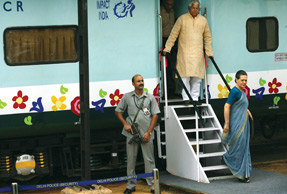|
Grateful patients bearing small bags of fruit and vegetables are common
along the railway platforms where Lifeline Express — the world’s first hospital
on rails — halts for three-week camps across rural India. So when a distraught
parent dropped a bundle into Zelma Lazarus’s lap at one of the stations and
begged her to help his son who had lost his arms in a threshing machine
accident, the CEO of Impact India, the foundation that created Lifeline, took
it in stride — until she opened the bag and found the severed limbs.
“The rural poor often slip through the gaps in the public health
system,” Lazarus says. “Lifeline Express is like a magic train to them, and
they expect us to perform miracles.” In this particular case, the “magic train”
couldn’t help, but Impact India could: The foundation brought the boy to
Mumbai, where he was fitted with a pair of artificial limbs.
The mission of Lifeline Express is to vanquish avoidable blindness,
deafness and physical handicaps. After 19 years and nearly 600,000 surgeries,
the train and its 100,000 volunteers have not even scratched the surface of
disability in India. Impact India’s chairman, A. H. Tobaccowala, estimates that
the train has reached less than 10% of the population in need of medical
attention.
When the Impact Foundation was set up in 1981 by Sir John Wilson — a
prominent British supporter of the disabled who himself was blinded in a
laboratory accident at school — three United Nations agencies threw their
weight behind the organization, with the understanding that it would be run as
a public-private partnership. Accordingly, Impact India was founded in 1983
with managerial and technical support from the Tata Group conglomerate.
Tobaccowala and Lazarus, who were respectively chairman and general manager of
corporate affairs at a Tata Group company called Voltas, were seconded to the
new foundation and have been there since.
Making Tracks
Impact India initially focused on immunization and prevention of
diseases such as polio and malaria. In 1989, it started “Cure on Wheels,” a van
that traveled around the hinterland, dispensing medical and surgical treatment
to people beyond the reach of the state-funded basic health service. But the
care the van was able to provide was still too little and, often, too late.
Impact wanted to extend medical services to larger numbers of people in even
more remote parts of the country. The challenge, however, was that sterile
facilities for the surgeries and post-operating recovery were needed, while
procedures had to be consistently replicable across the country. This was
clearly a task beyond what a van could do. So Impact turned to India’s railway
system — all 109,000 kilometers (68,000 miles) of it.
 |
Three old, wooden carriages were donated by Indian Railways and
renovated to the foundation’s specifications. An air-conditioned operating
theater with three adjustable tables, a diagnostic center, a sterilization
chamber and a post-operative recovery room were installed in one carriage. The
other two contained the living quarters, pantry, office and pathology lab.
Funding for the overhaul came from international charities, such as the Ford
Foundation, USAID and Impact UK. On July 16, 1991, Lifeline Express rolled away
from Mumbai to Khalari in Bihar state, then the smallest railway station in
India.
The present Lifeline Express has five customized carriages that were
unveiled in 2007. Indian Railways once again provided the carriages, and Impact
UK funded their overhaul. The new train has state-of-the-art facilities,
including an auditorium, public announcement system and closed-circuit cameras.
There is also a second, self-contained, two-table operating theater, which can
be detached from the rest of the train and function as a standalone unit in the
event of a disaster.
The train may be new, but the procedures have remained much the same
since the early days. Lasting three to four weeks, each project serves nearly
5,000 people and relies on community participation. At every stop, local
villages and non-governmental organizations offer various assistance, from food
and laundry services to crowd control (polite patients waiting in line and
disorderly mobs are equally common) to finding accommodations for post-operative
patients and family who accompany them.
The train has only a few permanent staffers, such as the cook, a
technician in charge of maintaining the pathology lab and computers, an
operating theater assistant and a driver. All medical specialists — surgeons,
doctors, nurses, anesthetists — are volunteers, providing the equivalent of
$80,000 of donated time for every project. At any given moment, a 20-person
medical team is on the train, working 15 hours a day.
Remote Control
Each project costs the foundation about $65,000. Typically, the sponsor
— generally companies such as Tata and Mahindra & Mahindra or state
governments — decides the location of the camp. Impact India’s only condition
is that it must be in a suitably remote location. Project work starts a month
before the train reaches the station. The Lifeline team liaises with the
district administration to make sure all the red tape — permits and so forth —
and publicity are dealt with before the train arrives. Town criers, flyers,
clowns on stilts and poster-draped elephants spread the news about the train
and urge people to register at the nearest community welfare center or primary
health center. Once selected, patients are called to a local school or marriage
hall, which serves as a makeshift waiting room.
The train treats “avoidable disabilities,” which means the focus is on
ear and eye ailments, as well as orthopedic and facial handicaps, such as
illnesses caused by polio and cleft palates. Typically, each specialty is run
as a week-long camp. Other ailments are also examined. Last year, a British
clinic sponsored a dental unit on the train and volunteered its services.
Neurosurgeons have begun treating epilepsy, while counseling superstitious,
often illiterate villagers about why the afflicted are not cursed or possessed
by evil spirits.
 |
Perhaps the greatest advantage Lifeline Express has over other health
services for the poor is its ability to reach “the doorstep of the patient,”
says G. Chandrasekhar, medical director of K.B.H. Bachooali Charitable
Ophthalmic & ENT Hospital in Mumbai. “My hospital also performs free
surgeries, but patients have to reach here. Lifeline Express takes me to the
patient.” Chandrasekhar has volunteered as an ophthalmic surgeon for the train
in 2005 and 2007, and says he’s waiting to be called again.
Three Lifeline Express trains now operate in China and Zimbabwe, while
hospital river boats based on the India model have been set up to tend to
patients in Bangladesh and Cambodia. Lifeline has inspired other projects in
India, too. In 2007, the government launched Red Ribbon Express to increase
awareness of HIV and AIDS, and Science Express to promote science among
students.
Tobaccowala may regret the large numbers that remain untreated, but
there is a consolation: The country’s government wouldn’t have reached even a
small fraction of the people helped by Lifeline Express. India’s public health
system is dangerously overstretched and large parts of the country have limited
or no access to basic medical care. Government spending on health, at 3% of
total its budget, is among the lowest in the world. There is one doctor to
every 870 people.
A recent government report notes that the low number of trained medical
professionals in India has led to a shortage of one million nurses, 600,000
doctors and 200,000 oral surgeons. The scarcity is especially pronounced in
rural areas. “Many of the people we treat have never been to a doctor before,”
Lazarus says. “People are so desperate for medical treatment they lie on the
tracks to stop the train from leaving.”
Seeking Sustainability
Despite all this, Lazarus says she wishes that the train would become
defunct. Why? “The train arrives at the platform, treats as many people as it
can and then leaves. It is not a sustainable solution for these people’s health
care needs. Once that is attained, there will be no need for a Lifeline
Express.” To address health care needs over the longer term, Impact India
started an initiative in 2005 in Maharashtra state. The grassroots program aims
to reduce disability by improving community health and neonatal and maternal
care by focusing on malnutrition, sanitation, hygiene and family planning. To
get the message across, mobile clinics are equipped with LCD screens showing
film clips about health-related issues, while a local art form called Warli
painting is used on posters, clothing, walls and even water pots to spread the
word.
“Hospitals are already overworked treating patients. They can’t focus
on prevention and awareness,” says G.V. Rao, country director of Orbis India, a
blindness-prevention nonprofit. “That can be done by trains and planes to draw
attention to these preventable and easily treated ailments.” Orbis’s Flying Eye
Hospital travels the world with volunteer surgeons, who treat patients and
train local specialists in eye care. In India, Rao says, Orbis has screened
more than 3.5 million children over the past eight years, treated nearly
600,000 people and performed more than 60,000 surgeries. “Policy-level changes
are needed,” Rao says. “Children should be screened for basic health issues
during school enrollment. Diet and nutrition issues should also be tackled at
the primary level.”
For India’s rural poor, prevention is essential because the chance for
a cure may never arrive. More than budgetary support, it requires an approach
to rural health care emphasizing nutrition and immunization. Until that
happens, there will always be offerings of fruit and flowers for the doctors on
board Lifeline Express.
|




